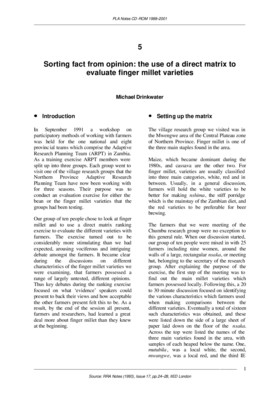PLA Notes CD-ROM 1988-2001 5 Sorting fact from opinion: the use of a direct matrix to evaluate finger millet varieties

Document begins: PLA Notes CD-ROM 19882001 5 Sorting fact from opinion: the use of a direct matrix to evaluate finger millet varieties Michael Drinkwater Introduction Setting up the matrix In September 1991 a workshop on The village research group we visited was in participatory methods of working with farmers the Mwengwe area of the Central Plateau zone was held for the one national and eight of Northern Province. Finger millet is one of provincial teams which comprise the Adaptive the three main staples found in the area. Research Planning Team (ARPT) in Zambia. As a training exercise ARPT members were Maize, which became dominant during the split up into three groups. Each group went to 1980s, and cassava are the other two. For visit one of the village research groups that the finger millet, varieties are usually classified Northern Province Adaptive Research into three main categories, white, red and in Planning Team have now been working with between. Usually, in a general discussion, for three seasons. Their purpose was to farmers will hold the white varieties to be conduct an evaluation exercise for either the better for making nshima, the stiff porridge bean or the finger millet varieties that the ...
Cite this publication
Available at https://www.iied.org/g01461